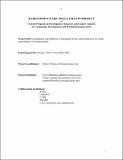Development and diffusion of integrated Striga control practices for small-scale farmers in western Kenya

View/
Publication Date
2002Author
Dennis Keith Friesen, GD Odhiambo, J Agunda, Andreas Oswald
Metadata
Show full item recordAbstract/
The parasitic weed Striga hermonthica has become one of the most significant constraints to cereal production in western Kenya. In 1995 a collaborative project among CIMMYT, the University of Hohenheim (UH) and the Kenyan Agricultural Research Institute (KARI) was initiated in order to develop agronomic Striga control technologies for Kenyan farmers. In collaboration with the NGO CARE-Kenya the most promising methods were tested on farmers’ fields. Crop performance, trial evaluation and feedback from farmers were key factors for the modification and selection of best techniques. Furthermore, based on this on-farm research training materials were developed to train extension agents and farmers.
The objectives of the Small Grant Project was to evaluate if the Striga control technologies and the participatory technology dissemination strategies developed during the previous project phase (1995-1998) would have an impact on adoption and knowledge creation among subsistence farmers. For this purpose CARE with its participatory approach to technology dissemination and the MoARD with its conventional extension approach backed-up by the Striga working group started to train farmers on Striga control in 1999. Additionally, the project wanted to test whether the CARE or MoARD approach would be more efficient and result in higher adoption rates.
